Black and white ducks are a beautiful sight in nature. These ducks have striking feathers with a mix of black and white colors, making them easy to spot on lakes, rivers, and ponds. They are found in many parts of the world and are known for their unique patterns. Some black and white ducks have solid black bodies with white patches, while others have intricate designs on their wings and heads. These ducks are not only pretty to look at but also play an important role in the ecosystem, helping to keep water bodies clean and balanced.
Top 10 Black and White Ducks
| No. | Duck Name | Description |
|---|---|---|
| 1 | Bufflehead | Small duck with a black back and white body. |
| 2 | Common Goldeneye | Black and white with a round white spot on the face. |
| 3 | Smew | Mostly white with black on the head and wings. |
| 4 | Hooded Merganser | Black and white with a striking crest on its head. |
| 5 | Barrow’s Goldeneye | Similar to the Common Goldeneye but with more white. |
| 6 | Common Eider | Black and white with a large, bulky body. |
| 7 | Long-tailed Duck | Mostly white with a black back and long tail feathers. |
| 8 | Surf Scoter | Black with a white patch on the forehead and nape. |
| 9 | Harlequin Duck | Dark with white spots and stripes on the head. |
| 10 | Greater Scaup | Black and white with a greenish-black head. |
10 Black and White Ducks
Black and white ducks are among the most striking birds you can find. Their contrasting colors make them stand out in the wild, and each species has its own unique beauty. In this article, we’ll explore ten different black and white ducks, looking at their appearance, habitats, and other interesting details.
1. Bufflehead
The Bufflehead is a small, compact duck with a large, rounded head. The male Bufflehead has a striking black-and-white appearance, with a black back and a white body. Its head is iridescent, showing colors like green and purple when the light hits it just right. The female is mostly gray-brown, with a small white patch on her cheek.
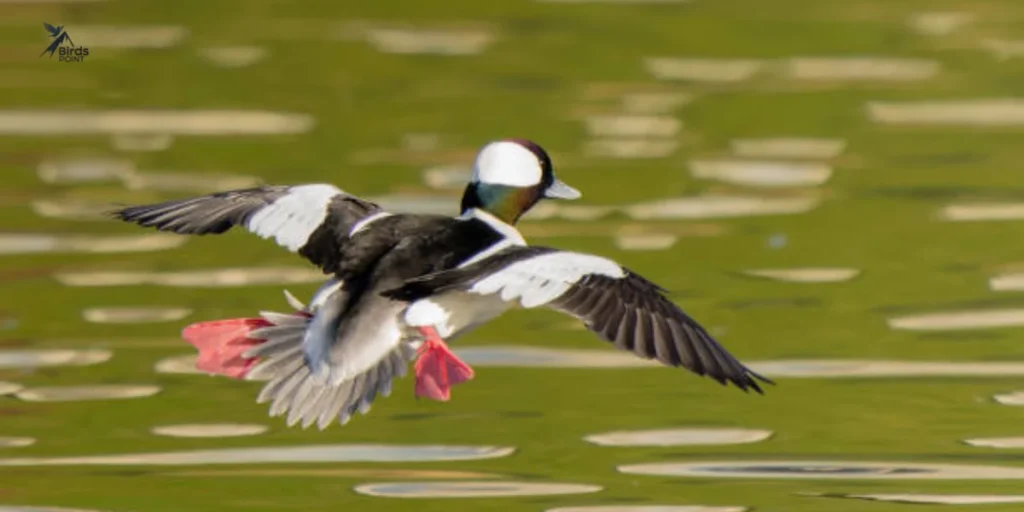
Buffleheads are often found in small ponds, lakes, and sheltered coastal waters. They are diving ducks, meaning they dive underwater to find their food, which includes insects, crustaceans, and aquatic plants. Buffleheads are also known for their rapid flight and small, choppy wingbeats.
| Characteristic | Details |
|---|---|
| Scientific Name | Bucephala albeola |
| Lifespan | 2–6 years |
| Size | 12.5–16 inches (32–40 cm) |
| Wingspan | 21 inches (53 cm) |
| Weight | 9–18 oz (255–510 g) |
| Habitat | Lakes, ponds, and coastal waters |
| Diet | Insects, crustaceans, aquatic plants |
2. Common Goldeneye
The Common Goldeneye is a medium-sized duck known for its bright yellow eyes and black-and-white plumage. The male has a black head with a round white spot near the bill, and its body is mostly white with some black on the back. The female is more subdued, with a brown head and grayish body.
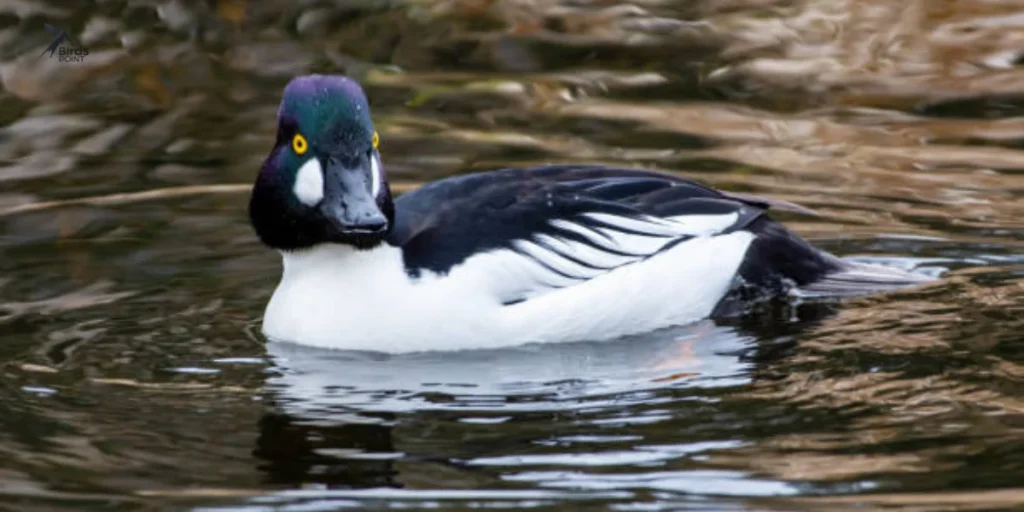
These ducks are found in forested areas near lakes and rivers, especially in the northern parts of North America and Eurasia. Common Goldeneyes are also diving ducks, feeding on fish, insects, and crustaceans. They often nest in tree cavities near water, and their young are known to leap from the nest to the ground soon after hatching.
| Characteristic | Details |
|---|---|
| Scientific Name | Bucephala clangula |
| Lifespan | 15–20 years |
| Size | 16–20 inches (40–51 cm) |
| Wingspan | 30–32 inches (76–81 cm) |
| Weight | 1.5–2.2 lbs (680–1000 g) |
| Habitat | Forested lakes, rivers |
| Diet | Fish, insects, crustaceans |
3. Smew
The Smew is a small, elegant duck with mostly white plumage and black markings on the head and wings. The male is especially striking, with a sharp contrast between the black and white, making it look almost like it’s wearing a tuxedo. The female, called a “redhead,” has a reddish-brown head and a gray body.
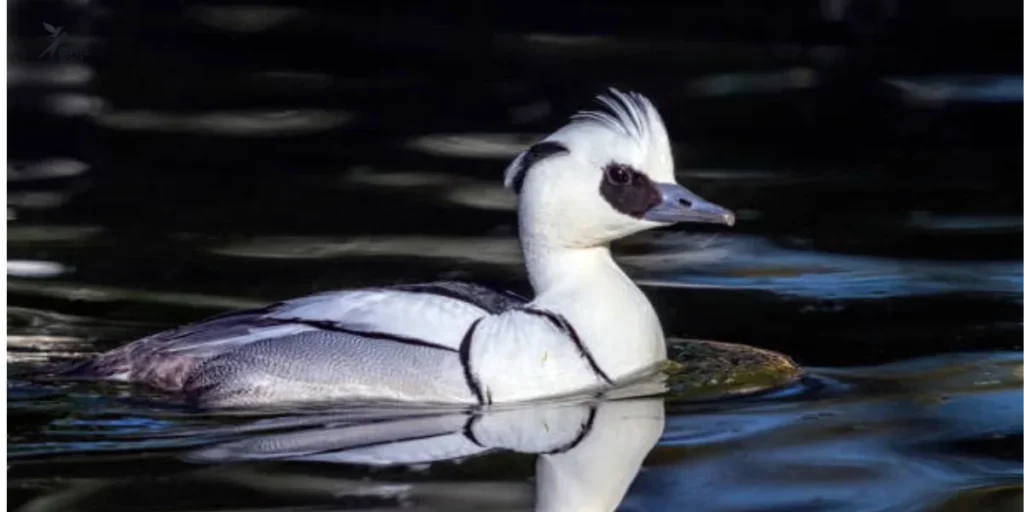
Smews are found in northern Europe and Asia, where they inhabit lakes, rivers, and coastal waters. They are excellent divers, feeding mainly on small fish. In winter, they migrate to more temperate regions, where they can be seen in larger flocks.
| Characteristic | Details |
|---|---|
| Scientific Name | Mergellus albellus |
| Lifespan | 7–12 years |
| Size | 14–16 inches (35–41 cm) |
| Wingspan | 22–27 inches (55–69 cm) |
| Weight | 1–1.3 lbs (450–600 g) |
| Habitat | Lakes, rivers, coastal waters |
| Diet | Small fish, insects |
4. Hooded Merganser
The Hooded Merganser is a small duck with a striking black-and-white crest on its head, which it can raise or lower depending on its mood. The male has a black head, back, and tail, with white on the chest and a large white patch on each side of the head. The female is more muted, with a brownish-gray body and a smaller crest.
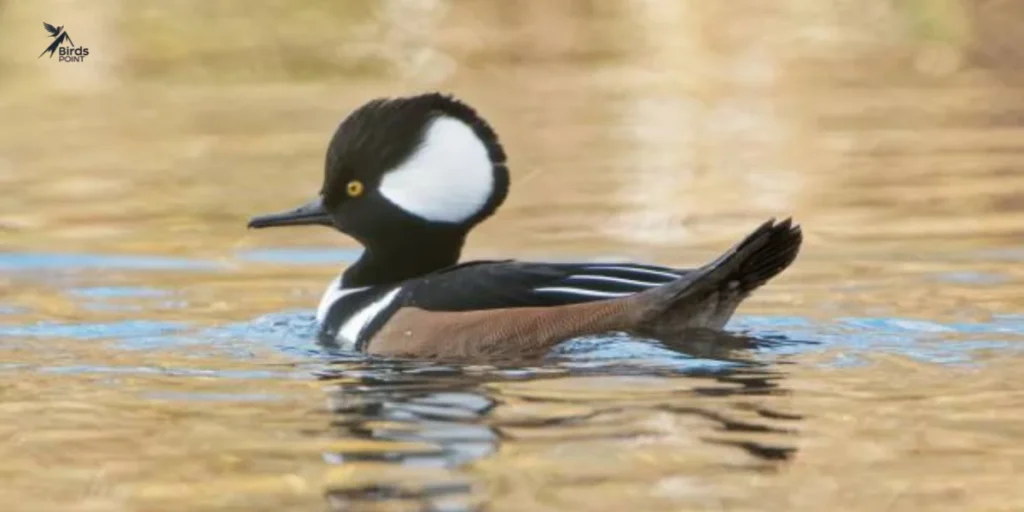
These ducks are found in forested wetlands, rivers, and ponds, particularly in North America. They are also diving ducks, with a diet that includes fish, insects, and crustaceans. Hooded Mergansers are known for their fast, agile flight and their ability to quickly take off from the water.
| Characteristic | Details |
|---|---|
| Scientific Name | Lophodytes cucullatus |
| Lifespan | 11 years |
| Size | 16–19 inches (41–48 cm) |
| Wingspan | 24.4 inches (62 cm) |
| Weight | 1.5 lbs (680 g) |
| Habitat | Forested wetlands, rivers, ponds |
| Diet | Fish, insects, crustaceans |
5. Barrow’s Goldeneye
Barrow’s Goldeneye is similar to the Common Goldeneye but has some differences that set it apart. The male has a glossy black head with a crescent-shaped white patch between the eye and the bill, while the female has a brown head with a yellow bill. The body of the male is mostly white, with some black on the back.

These ducks are typically found in clear, cold waters in the northern parts of North America. They prefer mountain lakes, rivers, and coastal areas. Like other diving ducks, Barrow’s Goldeneyes feed on a variety of aquatic invertebrates and small fish. They are also cavity nesters, often using old woodpecker holes or nest boxes.
| Characteristic | Details |
|---|---|
| Scientific Name | Bucephala islandica |
| Lifespan | 18 years |
| Size | 16–20 inches (40–51 cm) |
| Wingspan | 28–31 inches (71–79 cm) |
| Weight | 1.7–2.5 lbs (770–1130 g) |
| Habitat | Mountain lakes, rivers, coastal areas |
| Diet | Aquatic invertebrates, small fish |
6. Common Eider
The Common Eider is the largest duck in the Northern Hemisphere, known for its bulky body and soft, dense feathers. The male has a striking black-and-white appearance, with a black cap, white back, and black belly. The female is mottled brown, providing excellent camouflage on the nest.
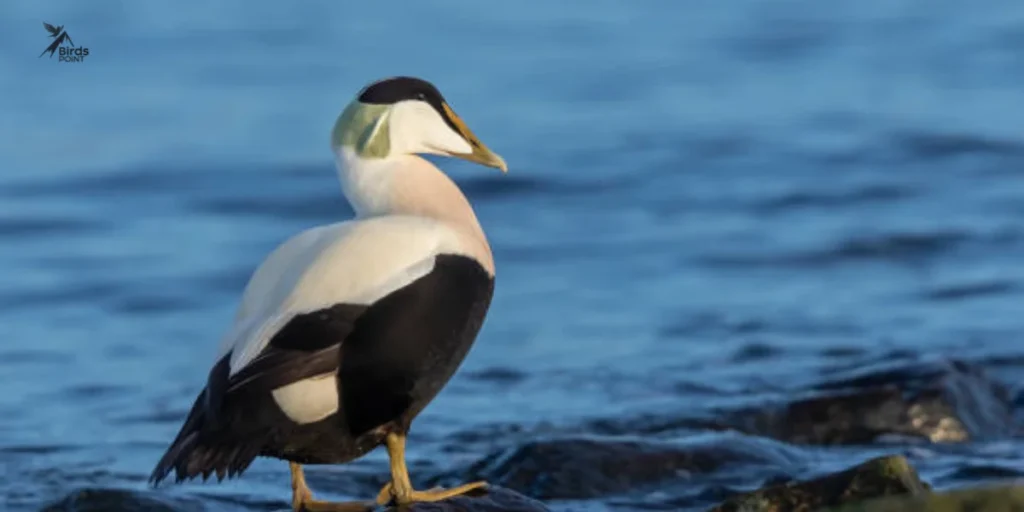
Common Eiders are found in the coastal waters of the North Atlantic, where they are well adapted to cold, harsh environments. They feed mainly on mollusks, such as mussels and clams, which they dive for in shallow waters. Eiderdown, the soft feathers from the female’s breast, has been traditionally used as insulation in bedding and clothing.
| Characteristic | Details |
|---|---|
| Scientific Name | Somateria mollissima |
| Lifespan | 20 years |
| Size | 20–28 inches (50–71 cm) |
| Wingspan | 38 inches (96 cm) |
| Weight | 3.3–6.6 lbs (1500–3000 g) |
| Habitat | Coastal waters, islands |
| Diet | Mollusks, crustaceans |
7. Long-tailed Duck
The Long-tailed Duck is a small, graceful duck with a distinctive long tail that is most prominent in males. The male has a striking black-and-white plumage, with a black back and a white face and underparts. The female is more subdued, with a brownish-gray body and a shorter tail.
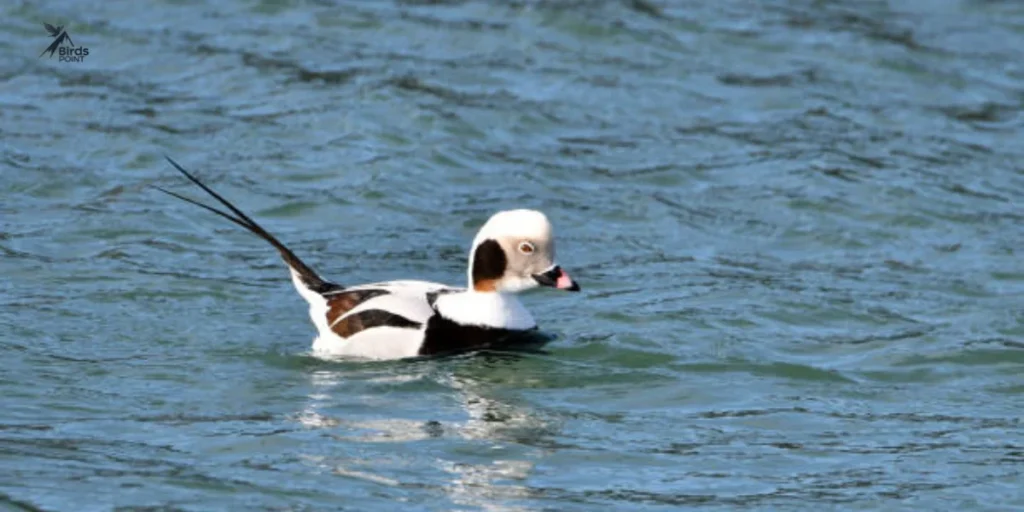
These ducks are found in the Arctic and sub-Arctic regions, where they breed in tundra lakes and coastal waters. In winter, they migrate to more temperate regions, where they can be seen in large flocks. Long-tailed Ducks are excellent divers, often feeding on small fish, mollusks, and crustaceans at great depths.
| Characteristic | Details |
|---|---|
| Scientific Name | Clangula hyemalis |
| Lifespan | 15–18 years |
| Size | 15–20 inches (38–51 cm) |
| Wingspan | 28 inches (71 cm) |
| Weight | 1.5–2 lbs (680–900 g) |
| Habitat | Arctic tundra, coastal waters |
| Diet | Small fish, mollusks, crustaceans |
8. Surf Scoter
The Surf Scoter is a large sea duck with a distinctive black-and-white appearance. The male is mostly black, with a white patch on the forehead and another on the nape of the neck. The female is browner, with less distinct markings. Both sexes have large, colorful bills, with the male’s bill being particularly bright and swollen.
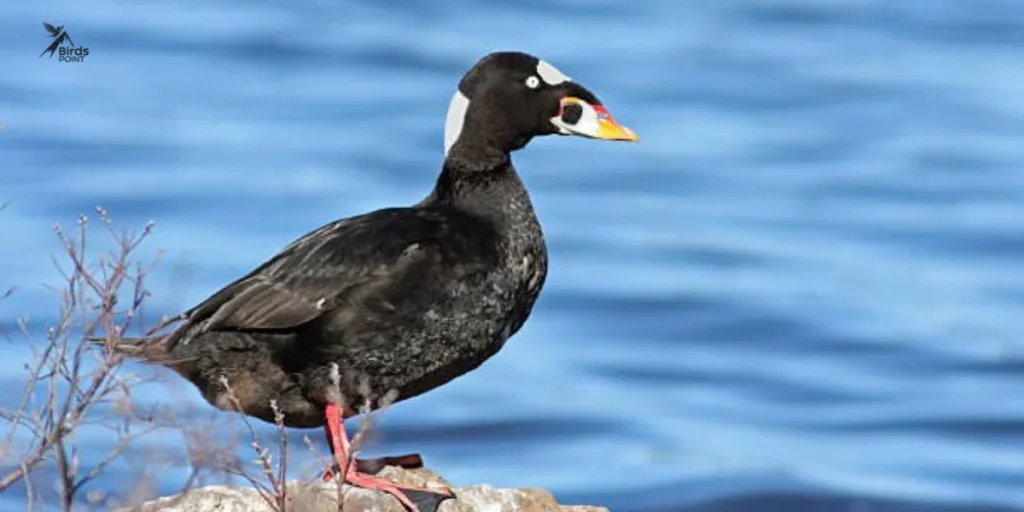
Surf Scoters are found along the coasts of North America, where they feed on mollusks, crustaceans, and other marine invertebrates. They are strong swimmers and divers, often diving in rough surf to find food. In winter, they can be seen in large flocks along the coast, often mingling with other sea ducks.
| Characteristic | Details |
|---|---|
| Scientific Name | Melanitta perspicillata |
| Lifespan | 10–12 years |
| Size | 19–24 inches (48–61 cm) |
| Wingspan | 30–31 inches (76–79 cm) |
| Weight | 2–2.75 lbs (900–1250 g) |
| Habitat | Coastal waters, bays, estuaries |
| Diet | Mollusks, crustaceans, marine invertebrates |
9. Harlequin Duck
The Harlequin Duck is one of the most colorful ducks in North America, with a striking mix of black, white, and slate-blue plumage. The male has bold white markings on the head, neck, and body, while the female is more muted, with a brownish-gray body and white spots on the face.
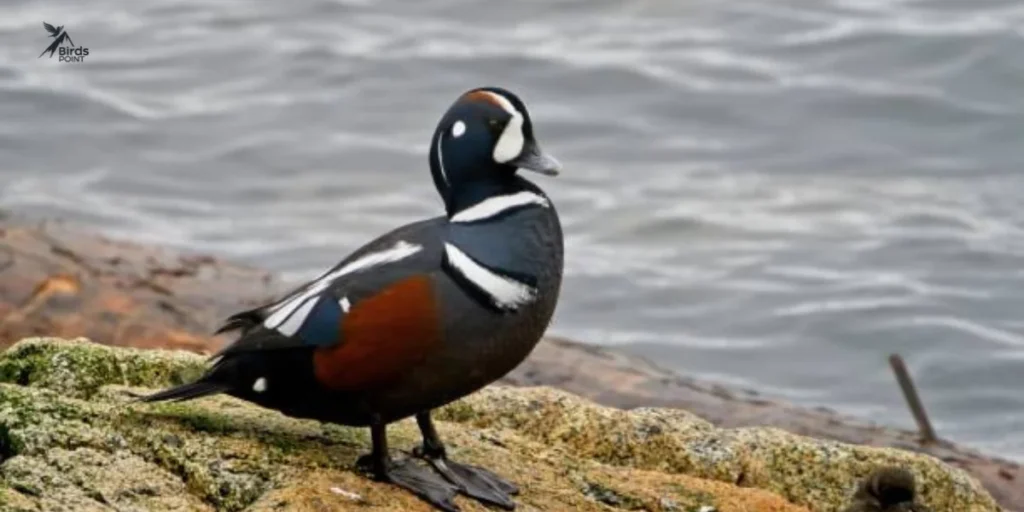
These ducks are found in fast-moving rivers and rocky coastlines, particularly in the northern parts of North America and Asia. They are excellent swimmers, often diving in turbulent water to catch small fish, insects, and crustaceans. Harlequin Ducks are also known for their strong pair bonds, often returning to the same breeding site year after year.
| Characteristic | Details |
|---|---|
| Scientific Name | Histrionicus histrionicus |
| Lifespan | 12–14 years |
| Size | 13–16 inches (33–41 cm) |
| Wingspan | 26–28 inches (66–71 cm) |
| Weight | 1.3–1.6 lbs (600–725 g) |
| Habitat | Fast-moving rivers, rocky coastlines |
| Diet | Small fish, insects, crustaceans |
10. Greater Scaup
The Greater Scaup is a medium-sized diving duck with a round head and a striking black-and-white appearance. The male has a black head, neck, and breast, with a white body and a black tail. The female is brown with a white patch near the base of the bill.
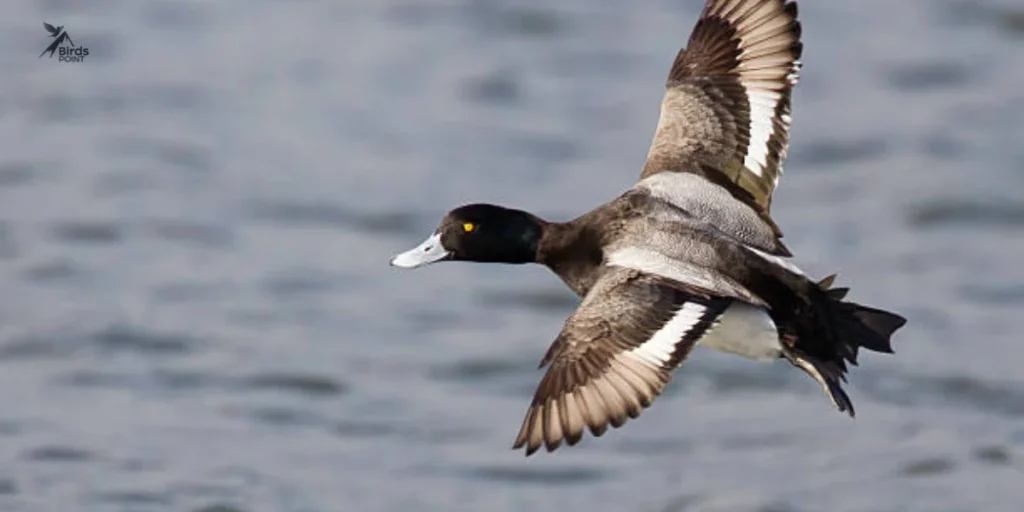
Greater Scaups are found in lakes, rivers, and coastal waters in the northern parts of North America and Eurasia. They are often seen in large flocks, particularly in winter, when they gather in sheltered bays and estuaries. These ducks feed mainly on mollusks, crustaceans, and aquatic plants, diving to the bottom to find their food.
| Characteristic | Details |
|---|---|
| Scientific Name | Aythya marila |
| Lifespan | 10–15 years |
| Size | 16–20 inches (41–51 cm) |
| Wingspan | 28–31 inches (71–79 cm) |
| Weight | 1.6–2.9 lbs (725–1320 g) |
| Habitat | Lakes, rivers, coastal waters |
| Diet | Mollusks, crustaceans, aquatic plants |
Conclusion
Black and white ducks are a diverse and fascinating group of birds, each with its own unique appearance and behaviors. Whether you spot a tiny Bufflehead on a quiet pond or a large Common Eider along a rocky coast, these ducks are sure to capture your attention. Their striking plumage not only makes them stand out but also serves important purposes in their lives, from attracting mates to providing camouflage. As you explore wetlands, lakes, and coastal areas, keep an eye out for these beautiful black and white ducks, and take a moment to appreciate the diversity and beauty they bring to the natural world.
FAQs
Q1: What are black and white ducks called?
A: Some common black and white ducks include the Bufflehead, Common Goldeneye, and Hooded Merganser.
Q2: Where can I find black and white ducks?
A: These ducks are often found in lakes, rivers, coastal waters, and wetlands, depending on the species.
Q3: What do black and white ducks eat?
A: Most black and white ducks eat a diet of fish, insects, crustaceans, and aquatic plants.
Q4: Are black and white ducks migratory?
A: Yes, many black and white ducks migrate seasonally, especially those living in colder regions.
Q5: How can you identify black and white ducks?
A: Look for distinct black-and-white plumage, along with unique features like size, shape, and beak color to identify different species.

2 thoughts on “Top 10 Black and White Ducks: Identification and Pics”